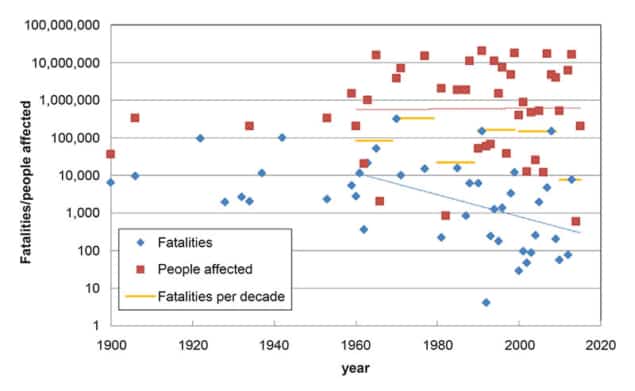
Storm surges following windstorms or cyclones are responsible for an average of 8000 deaths every year. New research shows that storm surges have become less deadly over time but will this trend continue as rates of coastal urbanization increase, tropical cyclones intensify and sea level rises?
In 1970 a devastating tropical cyclone struck present day Bangladesh and India’s West Bengal. The storm, and its resulting storm surge, cost more than 300,000 people their lives, and made the Bhola cyclone the deadliest tropical cyclone ever recorded. Today the population living in that region is greater, so how many casualties should we expect if a storm equivalent to Bhola were to strike tomorrow?
To investigate the change in risk, Laurens Bouwer from independent Dutch research institute Deltares and Bas Jonkman from Delft University of Technology, also in The Netherlands, analysed the impact of coastal storm surge events occurring between 1900 and 2015, based on a compilation of events and data on loss of life.
For the 121 events that occurred during this time, Bouwer and Jonkman showed that the occurrence of very substantial loss of life – more than 10,000 people – from a single event has decreased over time. And although population in coastal areas has increased rapidly in most regions (world population has increased six-fold since 1900), there was a striking drop in total number of fatalities over time, suggesting that populations have become better prepared and protected.
“In 1900 coastal protection was still absent in many places, and little or no monitoring, forecasting and early warning of surge events was in place,” said Bouwer. “In many developed countries, since the 1950s, monitoring and early warning has become common practice. And in recent decades cyclones are being monitored and tracked in all large ocean basins using observations (satellite, airplanes), and forecasted using models.”
What’s more, many investments have been made in coastal protection, Bouwer added. “We take these developments to be explanations of better protection of lives around the world.”
However, South East Asia bucked this trend and showed no decrease in mortality. This was the only region of the world to continue having high mortality storm surges after 1992, with events such as Cyclone Nargis in 2008, which killed more than 138,000 people in Myanmar.
“The high mortality in Myanmar can be explained by the absence of sufficient protection, forecasting and early warning systems in this country,” write Bouwer and Jonkman in Environmental Research Letters (ERL) .
By contrast similarly large storm surges in Bangladesh – from Cyclone Sidr in 2007 – and the Philippines – from 2013’s Cyclone Haiyan – were very serious, but better early warning and evacuation procedures meant that they did not kill as high a proportion of the exposed population. As many as 10,000 people lost their lives from Cyclone Sidr, but as Bangladesh’s Bhola cyclone in 1970 demonstrated, it could have been far, far worse.
Looking ahead Bouwer and Jonkman expect the mortality rate from storm surges to fall further as warning and evacuation strategies are improved in developing countries. However, this gain in lives saved could be offset by the impacts of climate change. “Flood hazard may increase, because of sea-level rise, leading to lowered protection levels from coastal defences and potentially higher inundation levels,” said Bouwer. “Also, if cyclones become more intense, they can produce higher waves and surge levels.”
Locations where warning and evacuation procedures continue to be poor, such as Myanmar, will continue to be highly vulnerable to storm surge events, but in addition low-lying countries with few flood defences, such as the Philippines, Bangladesh and small Pacific Ocean islands, are likely to become more vulnerable as sea-level rises and cyclones intensify.
“Further investments must be made to sufficiently protect lives and assets,” said Bouwer. “Also plans need to be made to keep up with projected sea-level rise, in order to guarantee protection in the future.”


